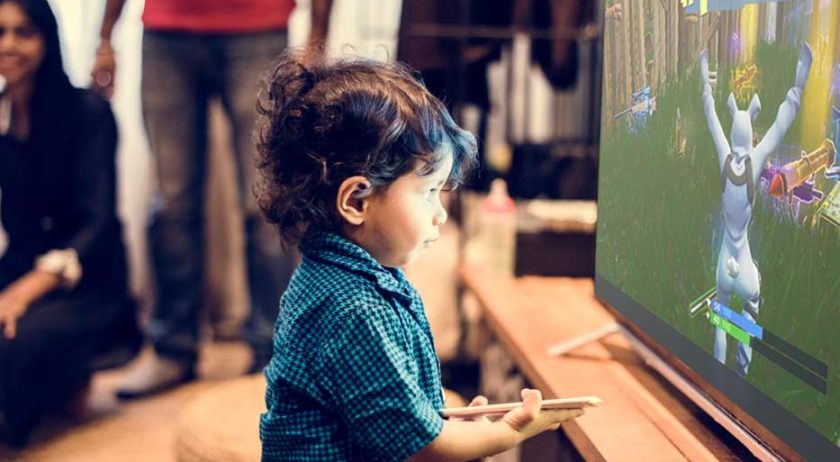There are kids who play Fortnite 14 hours a day. This is not an exaggeration! Whether we chalk this up to poor parenting, addiction to Fortnite, or the power of screens to grab our children’s attention, it’s unhealthy. At the most basic level, kids who spend more than a few hours a day playing video games don’t have much time to do other things. Other activities such as getting exercise, spending time with family and friends, and engaging in creative and unstructured time are crucial to learning, social-emotional development, and, ultimately, psychological health and happiness. With video games in particular, there is compelling research suggesting that playing about one hour a day is actually good for kids, as it leads to a sense of psychological adjustment and connection with peers and provides a dose of cognitive challenge that helps kids learn. Playing up to three hours a day is generally not harmful, at least according to the research, but I would question whether kids who spend three hours a day playing video games (and probably also using social media and additional technology) have enough time to pursue other interests. The reality is that preteens and teens spend anywhere from six to nine hours a day with their screens. While some of this may be related to schoolwork and learning, much of it is in involved with social media, listening to music, watching videos, and playing video games. So how much time should your child play Fortnite?
I’m using Fortnite as an example because it has become so popular that parents all over the world are concerned. In just in the past few weeks I’ve been approached by eight media outlets for my opinions about how much kids should play Fortnite. I have spoken to parents who have legitimate concerns about their kids being addicted to Fortnite. Some have gone as far as looking into video game rehab centers.
My advice about Fortnite is pretty much what I say about other games: ensure that a game is appropriate for your child and focus on developing a healthy Play Diet, where other play activities (exercise, socializing, creative tasks, and unstructured/ non-digital time) are expected and routine. I have concerns about Fortnite for younger children due to the underlying nature of a game in which killing everyone else to ensure one’s own survival is at its core. My second reservation about Fortnite is that its structure can be particularly problematic for kids who have addictive tendencies. I have observed more ‘addictive-like behaviors in my patients diagnosed with ADHD, Autism, Learning Disabilities, Executive Functioning problems, Anxiety, or Depression.
Generally, I suggest that preteens should not play the game. Teenagers, on the other hand, are likely to have cognitive developmental features necessary to understand the fantasy nature of the game and to view its “all for one-survival” nature as simply a game-based challenge. Kids playing one to two hours a day with their friends from school are unlikely to be negatively impacted by Fortnite play. However, there are many kids for whom Fortnite is no longer an occasional game to play but an obsession, and even at times an addiction. While addiction is rare, it is very serious. Most kids who play too much Fortnite are best characterized as overusing technology. Some of the following recommendations would be helpful for them.
Here are suggestions that can help parents know how much time their child should play Fortnite and how to create reasonable limits on screen time:
Limit screen time to certain times of the day. Create family-designated times when digital media are not used. Shutting off all digital media except for music after 9 p.m. can help family members get some rest prior to going to bed. It is important to keep devices off, rather than on. The need to turn on tablets, cell phones, computers, and other devices makes them less accessible.
Allow your child to have screen time to do things of interest. Consider his interests. If he enjoys movies and theater, allowing him time on the Internet to watch films and to learn about actors, directors, set design, and the filmmaking process could be an opportunity for sustaining his interest in the field. If he is curious about history, watching the History Channel, playing games such as Civilization V, or using an app such as History Here could encourage his academic pursuits in this area. Children who like to create their own videos or learn how to mod, program, or create websites are often building the skills for a career in technology and should be encouraged to create using services such as YouTube and Scratch. Those who enjoy technology and are engaged in educational activities may need encouragement to partake in other forms of play but require monitoring rather than restriction.
Have regular but rigid limits on screen time limits. Set up highly structured limits with little variation so that children know exactly when and how long they can use digital media. While different limits could be determined for weekends, holidays, and school days, they should not waver within this framework. Children who become overly involved in things such as Facebook and texting may need parents to shut off the Internet at night, contact their cell-phone provider to stop texts during a certain time, not allow them to have a computer in their room, or not permit them to have a smartphone. Parents could also use browser add-ons such as LeechBlock or parental controls to regulate access to home video game consoles, handhelds, and Windows computers.
Have reasonable priorities before the use of screen time. This technique depends heavily on the nature of the child and the parents’ availability for supervision and guidance. While it is strongly recommended that children who struggle in school complete all or most of their homework before being allowed screen time, it may be unreasonable for some children to come home from school, take only a brief exercise or relaxation break, and then return to hours of schoolwork. These children could benefit from getting their most difficult homework done before playing a video game, browsing the Internet, or using their cell phones.
Focus on the content of screen time rather than the amount of screen time. Older students who have a project or school paper due might need to spend a significant amount of time researching material on the Internet. This should be considered educational time, even if they get waylaid by reading their favorite blog or watching a few YouTube videos. Judge media use based on the character of the content rather than the amount of time spent with it.





